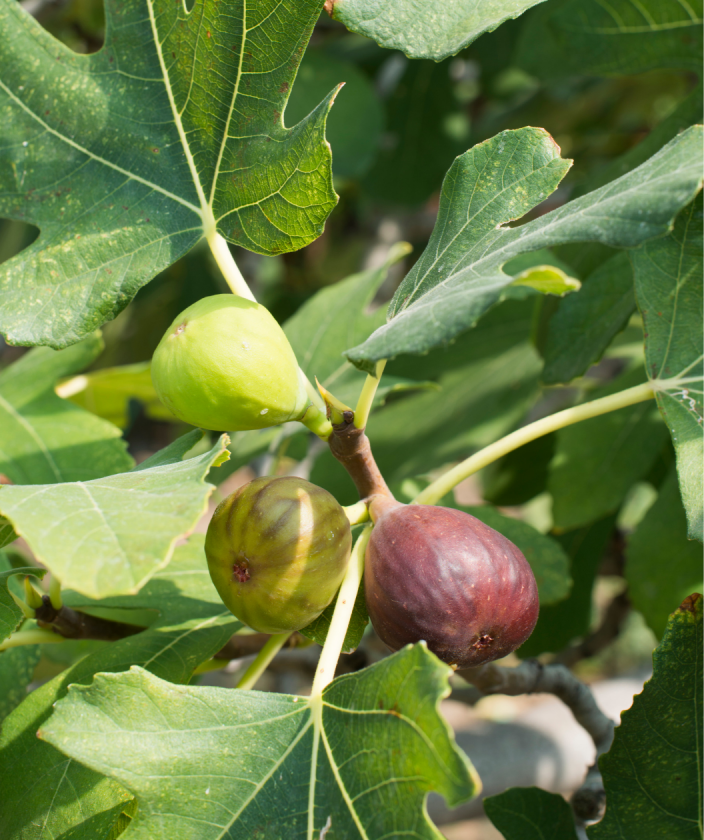

Cold-hardy fig that brings rich, sweet flavor and lush, tropical beauty to gardens far beyond warm southern climates
FEATURES:
- Sold in bundles
- Produces medium-sized, sweet purple-brown figs
- Exceptionally hardy and can survive colder winters
- Self-pollinating and easy to grow
- Lush, deeply lobed green leaves add tropical texture
- Bears fruit on new and old wood for dependable harvests
- Perfect for in-ground planting or container growing
- Ships on our trucks because of the size of the tree; does not fit in a box
Bower & Branch Landscape Design Tip
Plant your Chicago Hardy Fig in a sunny, well-drained location protected from harsh winter winds. In colder climates, mulch heavily around the base in late fall to insulate the roots. If growing in a container, choose a large pot with drainage holes and move it into a cool garage or basement during winter dormancy. Prune in early spring to maintain size and encourage new fruiting growth. Pair it with herbs, lavender, or ornamental grasses for a lush, inviting garden space that feels both productive and peaceful.
Growth Facts
- Hardiness Zone: 5-10
- Mature Height: 10-15' tall
- Mature Width: 9-12' wide
- Exposure: Full Sun
- Spacing: 10-15' apart
Cold-hardy fig that brings rich, sweet flavor and lush, tropical beauty to gardens far beyond warm southern climates
FEATURES:
- Sold in bundles
- Produces medium-sized, sweet purple-brown figs
- Exceptionally hardy and can survive colder winters
- Self-pollinating and easy to grow
- Lush, deeply lobed green leaves add tropical texture
- Bears fruit on new and old wood for dependable harvests
- Perfect for in-ground planting or container growing
- Ships on our trucks because of the size of the tree; does not fit in a box
Bower & Branch Landscape Design Tip
Plant your Chicago Hardy Fig in a sunny, well-drained location protected from harsh winter winds. In colder climates, mulch heavily around the base in late fall to insulate the roots. If growing in a container, choose a large pot with drainage holes and move it into a cool garage or basement during winter dormancy. Prune in early spring to maintain size and encourage new fruiting growth. Pair it with herbs, lavender, or ornamental grasses for a lush, inviting garden space that feels both productive and peaceful.
Growth Facts
- Hardiness Zone: 5-10
- Mature Height: 10-15' tall
- Mature Width: 9-12' wide
- Exposure: Full Sun
- Spacing: 10-15' apart
Why plant Chicago Hardy Fig?
Sweet, juicy figs. They’re so soft and perishable, you almost never see them at the grocery store. You pretty much have to grow your own tree to be able to have your fill of these decadent morsels. But don’t Fig Trees only grow in warm climates? Not anymore! With the Chicago Hardy Fig Tree, even if you live in the North, you can know the pleasure of having delectable sun-ripened figs right outside your door. Let them mature to perfection, and they’ll develop a mouth-watering honey-sweetness. With fiber and a nice assortment of vitamins and minerals in every bite, this is all-natural snacking you can feel good about, too!
How to use Chicago Hardy Fig in the landscape?
Your Chicago Hardy Fig Tree will turn you into a fig fanatic. There are so many delicious ways to enjoy figs! You can add them to bars and smoothies, make elegant tarts with them, punch up salads with them, even throw them on a pizza. Figs make classy hors d’oeuvres when stuffed with blue cheese, honey, and walnuts, and fig jam is a wonderful way to relive fig season when there are no more fresh fruits to satisfy your craving.
How To Plant Chicago Hardy Fig
Grow your Chicago Hardy Fig Tree in full sun. A site in front of a south-facing wall will provide additional warmth in northern climates, giving you more fruit. Well-drained soil is a must, and your tree will be relatively drought tolerant once it is established. In very cold climates, you may choose to wrap your tree in the winter with fiberglass insulation or build a chicken wire cage around it, filling it with mulch or dry leaves. Figs also grow happily in pots and can spend the winter in an unheated garage. They do require a cold period in dormancy, so don’t put it in a heated room or greenhouse.
How To Water
Fig Trees will appreciate watering deeply, and regularly during its first few years in the ground. Irrigate weekly, and especially during long dry spells or extreme heat after it’s established.
How To Prune
If needed, pruning on your Fig should be done during winter, when it is dormant.
Frequently Asked Questions
Chicago Hardy can tolerate winter temperatures down to around 10°F, and even if the top growth dies back, it reliably resprouts from its roots each spring.
No. It is self-pollinating, so you only need one tree to enjoy a bountiful harvest of figs each season.
It typically bears fruit in late summer to early fall. In warmer climates, it may also produce an early crop in midsummer.




